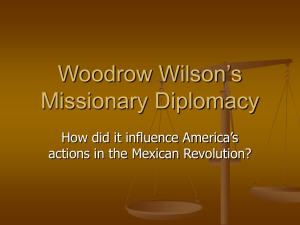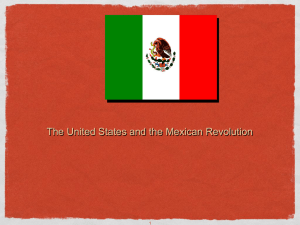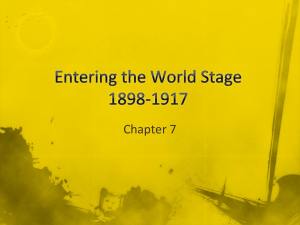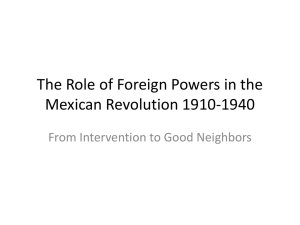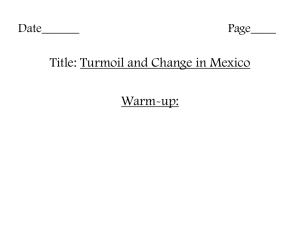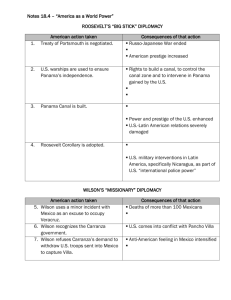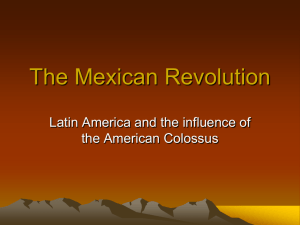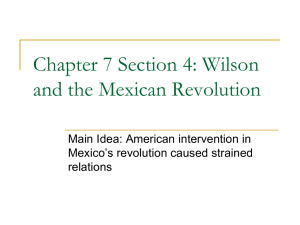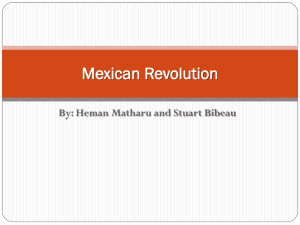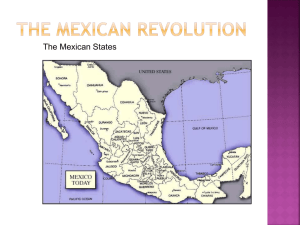Mexican Revolution Outline for Class Swap
advertisement
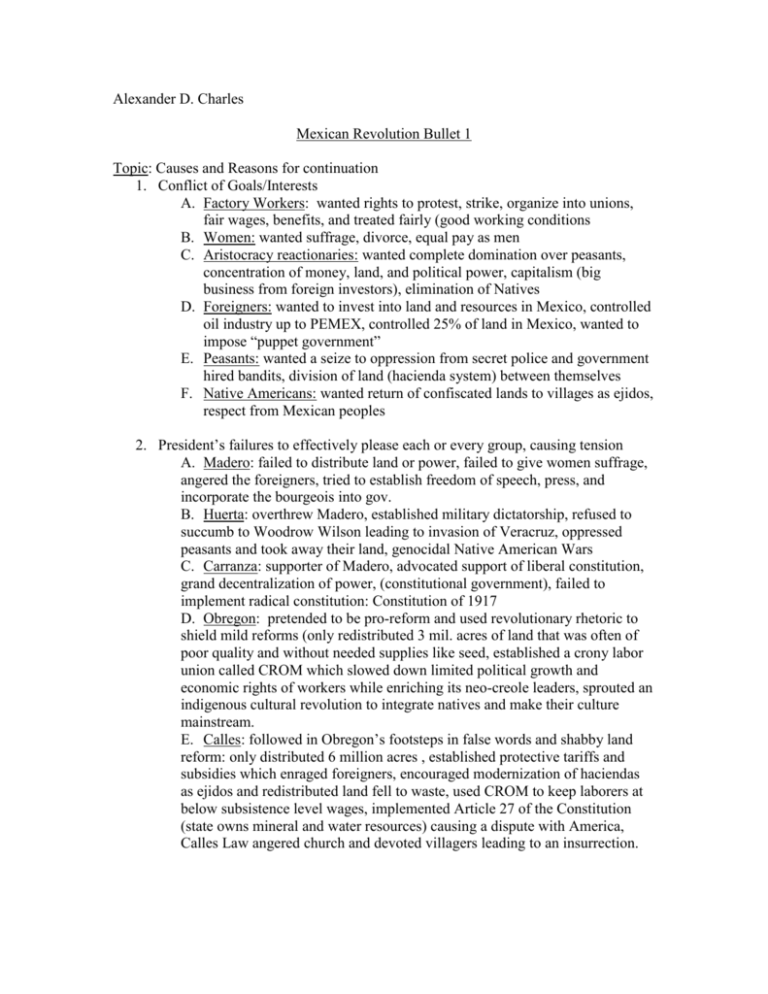
Alexander D. Charles Mexican Revolution Bullet 1 Topic: Causes and Reasons for continuation 1. Conflict of Goals/Interests A. Factory Workers: wanted rights to protest, strike, organize into unions, fair wages, benefits, and treated fairly (good working conditions B. Women: wanted suffrage, divorce, equal pay as men C. Aristocracy reactionaries: wanted complete domination over peasants, concentration of money, land, and political power, capitalism (big business from foreign investors), elimination of Natives D. Foreigners: wanted to invest into land and resources in Mexico, controlled oil industry up to PEMEX, controlled 25% of land in Mexico, wanted to impose “puppet government” E. Peasants: wanted a seize to oppression from secret police and government hired bandits, division of land (hacienda system) between themselves F. Native Americans: wanted return of confiscated lands to villages as ejidos, respect from Mexican peoples 2. President’s failures to effectively please each or every group, causing tension A. Madero: failed to distribute land or power, failed to give women suffrage, angered the foreigners, tried to establish freedom of speech, press, and incorporate the bourgeois into gov. B. Huerta: overthrew Madero, established military dictatorship, refused to succumb to Woodrow Wilson leading to invasion of Veracruz, oppressed peasants and took away their land, genocidal Native American Wars C. Carranza: supporter of Madero, advocated support of liberal constitution, grand decentralization of power, (constitutional government), failed to implement radical constitution: Constitution of 1917 D. Obregon: pretended to be pro-reform and used revolutionary rhetoric to shield mild reforms (only redistributed 3 mil. acres of land that was often of poor quality and without needed supplies like seed, established a crony labor union called CROM which slowed down limited political growth and economic rights of workers while enriching its neo-creole leaders, sprouted an indigenous cultural revolution to integrate natives and make their culture mainstream. E. Calles: followed in Obregon’s footsteps in false words and shabby land reform: only distributed 6 million acres , established protective tariffs and subsidies which enraged foreigners, encouraged modernization of haciendas as ejidos and redistributed land fell to waste, used CROM to keep laborers at below subsistence level wages, implemented Article 27 of the Constitution (state owns mineral and water resources) causing a dispute with America, Calles Law angered church and devoted villagers leading to an insurrection. F. Cardenas: radicalized Mexico, redistributing 46 million acres of land, ousting Callista and reactionary government officials, greatly angering the neo-creoles especially the Callistas 3. Civil Strife/Living Conditions A. Constant civil unrest: the main labor force of rural farmhands of both genders were in taking up arms in large armies to fight the government’s troops, sabotage of major mines and industry, burning of haciendas B. Intervention of the US: the trade with the US for military supplies added to the carnage of the war, physical intervention like the overthrow of Madero with Huerta (destabilized the national government and caused peasant unrest), the invasion of 1914 (weakened Huerta’s regime), and the invasion of 1916 which added to the insurrection and fighting already taking place in the North in addition to distracting Carranza from internal affairs Mexican Revolution Bullet 2 Topic: Leaders Thesis: “The Mexican Revolution of the early twentieth century was not one but two revolutions, one led by reformers and the other by revolutionaries.” Information: 1. Reformers-A reformer is a person who wishes to change a system to improve it. A. Madero Criticized Diaz’s social policies Proposed a policy of modest concessions to peasants and workers that would reduce mounting tensions and check the growth of radical ideas Regarded democracy as an instrument of social control that would promote the acceptance of capitalism through the grant of limited political and social reforms, with large stress on education (stability) Favored oligarchic façade democracy that would protect the elite from popular insurrection Treat of Ciudad Juarez (removal of Diaz but left intact all existing institutions) Labor unions created Against land reform at the expense of the haciendas (led to rift with Zapata) B. Carranza Plan de Guadalupe- called for overthrow of the dictator Huerta and restoration of constitutional government, but didn’t mention social reforms, and called for improved conditions for industrial workers and land reforms Constitution of 1917- related back to old constitution Didn’t intend to enforce regulations C. Calles Used radical phraseology to conceal the pragmatic policies he supported Promote rapid growth of Mexican capitalism Against Catholicism (calle’s law) D. Obregon Obregon’s four years in office were known for the agrarian and anticlerical reforms he instituted and for the cultivation of good relations with the United States, based on the sale of Mexican petroleum to the U.S. market. Anti-clerical Gave out small pieces of land slowly to peasants, but they were doomed to fail, since given no seeds, water source, or fertile soil (3 million acres given out during presidency, but 320 million acres remained in private hands) 2. Revolutionaries-A revolutionary, when used as a noun, is a person who either advocates or actively engages in some kind of revolution. A. Pancho Villa Villa and his supporters, known as Villistas, employed tactics such as propaganda and firing squads against enemies, expropriated hacienda land for distribution to peasants and villista soldiers, and robbed trains and printed fiat money to finance Villa's cause. Villa's generalship was noted for its speed of movement of his forces by railroad, use of cavalry and artillery attacks, and recruitment of enlisted soldiers of enemy units he defeated. Villa's revolutionary aims (other than military goals), unlike those of Emiliano Zapata's Plan de Ayala, were never clearly defined. Villa spoke vaguely of creating communal military colonies for his exsoldiers, and he subscribed to Venustiano Carranza's Plan of Guadalupe(document accused Huerta of restoring a dictatorship and committing treason by executing the Constitutional leader of Mexico) New Mexico attack and Punitive expedition in which he attacked New Mexico city because of loss of life because of defective bullets purchased from U.S.- a Punitive expedition was led into Mexico to look for Villa and to kill him (bounty was placed on his head) Villa wanted a strong gov. that supported the people and land for the peasants (radical) Expropriation without compensation of the holdings of the pro-Huerta oligarchy in Chihuahua Villa wanted seized land to remain in state control until the victory of the revolution- revenue from these estates would be used to finance the revolutionary struggle and support the women and children of the soldiers- once achieved revolution, large economic units created from cattle raising had to be administered by the state Percentage of peasants less in north and problem of land hunger was less acute B. Emiliano Zapata Liberation Army of the South (Zapatistas)- mainly poor peasants who wished to spend much of their time working their land to produce an income who were lead by Zapata Plan de Ayala- Zapata denounced President Francisco I. Madero for his perceived betrayal of the revolutionary ideals, embodied in Madero's Plan de San Luis (document or 'plan' called for the destruction of Diaz's authoritarian presidency and the re-institution of democracy through violent direct action on the part of the Mexican populace), and set out his vision of land reform 1. Rejection of Madero's presidency and a call for free elections once the situation in the country had stabilized 2. Naming of Pascual Orozco as the legitimate leader of the Revolution 3. Devolution of land and property to townships and citizens, as opposed to being owned by large hacendados; 4. Confirmation of the agrarian nature of the Revolution The Plan increased Zapata's standing and base from the lower classes in southern Mexico, as reflected by the increased membership to his Ejército Libertador del Sur ("Liberation Army of the South"). Together with Francisco Villa and Venustiano Carranza they succeeded to depose Huerta and champion a temporary peace. However, Zapata fell out of favor with Carranza and his Congreso Constituyente and began to battle this new foe. Carranza ultimately put a price for Zapata's head, leading to his assassination April 9, 1919. Wanted land for peasants- confiscated estates were promptly redistributed among the peasants C. Cardenas (sort-of) Organization of corporatist structures for trade unions and campesinos Party of Mexican Revolution Government expropriated and redistributed millions of acres of hacienda land to peasants Millions of industrial workers gained union rights and wage increases The railways was nationalized National oil and petroleum in Mexico was created (PEMEX) Mexican Revolution Bullet 3 Topic: Constitution of 1917 Thesis: There were many economic problems that brought around the Mexican Revolution. Most of them had to do with poverty and suffering through poor harvests and lands. These problems were solved by the Constitution of 1917 created under Carranza in which land reform and worker’s rights were emphasized, but they were still subject to subjection. Information: 1. Economic problems 95% of rural population didn’t own land Fewer than 1000 families owned most of Mexico, fewer than 200 owned a quarter, and foreigners had another quarter Low wages to workers, real wages lowered over time Poor working conditions (long days, highly intensive, low/no compensation for injury) Many haciendas held over one million acres a piece Larger urban middle class, increased dissatisfaction with poor working conditions Labor unions were inadequate Old policies insufficient to support future economic development Large influence of foreign investments on Mexican economy Essentially ruled as an oligarchy: few controlled the economic interests of an entire country 2. Constitution of 1917 Article 123: established an 8-hour day, childbirth benefits for women (paid parental and postnatal maternity leaves), childcare requirement for companies employing over 50 women, workers rights, strike privileges, and allowed for organization of workers and worker’s unions, women have equal rights in marriages o didn’t help- no enforcement of union rights, working class severely repressed under Carranza so not much actual change in women’s conditions, cultural taboos worked against women in terms of divorce, and other social inequalities in marriage, little power of women to influence economy o This labor code was the most advanced in modern day Article 27: made the national government the original ruler of all lands, subsoil, waterways, which can be expropriated by the govt., with compensation to their holders, for the benefit of Mexico. It also permitted ejidos, or communal lands, throughout Mexico. Lands for ejidos could be expropriated from neighboring haciendas. o Didn’t help- little land reform, some land actually returned to haciendas, nationalism really gets going under Cardenas In 1938, a boost was also given to Mexican economy when Cardenas established PEMEX to expropriate Mexican oil; he used article 27 to determine that it was a legal thing to do and it did bring some economic prosperity to Mexico Article 27 was akin to Villa’s practice of state controlled plantations and ranches not to mention the Plan de Ayala which stated the people owned all the resources 27 had provisions stating that the resources and land were owned by the state reviewed by the state though other entities may exploit them. This was also supported by the reformers who wanted to limit foreign control. Article 3 spawned the Calles Law, which was put in effect by him. Not often implemented Mexican Revolution Bullet 4 Topic: Effects 1. Both Radicals and Moderates 1) Were very successful in deposing conservative dictatorships by the end of the 1920’s Huerta Through the combined armies of Obregon, Carranza, Zapata, Pancho Villa, and the US occupation of Veracruz, both groups were able to depose Huerta in 1914 Diaz Through the aid of radicals Pancho Villa and Zapata, Madero was able to peacefully take Diaz out of power- Treaty of Ciudad Juarez in 1911 2) Reduce foreign influence Constitutional provisions Ability of Carranza to negotiate the Americans out of Veracruz, Mexico 1914 Villa fought the invading American army1916 and Carranza was able to get the US to back out of Chihuahua 2. Reformers 2) Appease the peasantry and factory workers in order to disarm their wants of equal rights and land by meager reforms Carranza pretends he is pro-land reform during the major warfare to attract a peasant base Obregon redistributes 3 million acres Calles redistributes 6 million acres Crony CROM gave workers the illusion that change was being made and the government was on their side; however, Obregon used it to keep the workers where they could see them and prolong or diminish their aspirations 3) Keep the hacienda system alive Carranza returns haciendas to hacenderos Only poor quality land is redistributed and without supplies Calles encourages planters to modernize their technology 4) Constitutional Government Able to implement new constitution However Constitution of 1917 was heavily radical and thus not implemented often Encouraged big business capitalism and foreign investment Reformers had almost complete control of the gov. (some reactionary and radical elements present) Regulated foreign influence 2. Achievement of Radical Goals 3. Also effective at deposing reactionary dictators and fought conjunctly with Reformers against Huerta Haciendas not distributed Sadly, Zapata’s Plan de Ayala for 1/3 haciendas partitioned and all confiscated land returned was not put into effect Pancho Villas’s efforts to de-land the Porifirian elite were reversed as Carranza returned hacenderos their land and destroyed land distribution by ejido system, the communal landholding system under which land couldn’t be mortgaged or alienated, with each ejidatario having a share of the big parcel land rancho redistribution (individual small holding) large scale cultivation of commercial crops with money from Banco de Credito Ejidial schools were created and growth occurred of the internal market, as well as more strikes occurred and new parties were established However, Cardenas was also sympathetic to private enterprise and he supported equal rights After his rule ended, his reforms went downhill however Also effective at deposing reactionary dictators and fought conjunctly with Reformers against Huerta. Haciendas not distributed Sadly, Zapata’s Plan de Ayala for 1/3 haciendas partitioned and all confiscated land returned was not put into effect Pancho Villas’s efforts to de-land the Porifirian elite were reversed as Carranza returned hacenderos their land and destroyed Social Reform Pancho Villa’s aid for the poor, widows, and orphaned were ended. Distributed meat Clothing and money too Education however was spread by Obregon and Calles in an effort to educate the natives and desecularize education Mexican Revolution Outline Bullet 5 Topic: US and other Foreigners Information: 1. The Mexican Revolution was a liberation against two tyrannies: the neo-creole converservative and oppressive Porfiristas under Diaz, and the cold hearted greedy foreign companies. Foreign private and business entities owned 25% of the land in Mexico Foreigners controlled the entire Mexican oil industry Foreigners controlled most industries 2. America’s role on the conduct of the war The US allowed Madero safe haven, ability to produce and announce the Plan de San Juan de Potosi, and conduct rebel meetings within their borders The US ambassador was a leader in the conspiracy to depose Madero by placing the diplomatic community against Mexico’s President and conspiring with Huerta. The US invaded Veracruz, Mexico in 1914 because they disliked Huerta’s instability and pro-European policies. This caused anti-American sentiment to increase and a universal opposition from all Mexican leaders to the US politically. The US tried to make Carranza their puppet in while Huerta was in decline from 1914-1915 1916, the US invaded again after Pancho Villa raided an American town. This caused heavy fighting in Chihuahua province between the two. Carranza almost declares war on the US for its intervention causing the US to back down and a diplomatic win for Mexico. Finally, the US sold weapons to all sides, (but especially the reactionaries) 3. Other Nations, mainly Germany and England, played an indirect, yet crucial role in the Mexican Revolution. In the years leading up to the revolution in 1911, Mexico had been giving more and more contracts to Europe instead of the US, which bothered it. This is the most important reason why the US allowed Madero to maneuver in Texas. In addition, the Huerta gov. received strong support and recognition from Britain and Germany Huerta’s regime favored European business over American, causing jealousy Then, after WWI broke out, Huerta’s two main foreign supporters were caught with their own affairs and the US took this opportunity to take intervene in Mexican affairs twice. 4. Finally, the fervent activities of the US and complacency of Europe led to some changes in Mexican economy and foreign relations Mexico halted the special priviledges it gave to the foreign companies In addition, it gained a more nationalistic political approach to dealing with foreign nations Next, it concentrated more on self-development and industrialization An example of Mexico’s new stance is the Nationalization of Oil led by Cardenas A. Mexican workers requested better wages from the foreign oil companies B. the Anglo-American companies and nations refuse C. Cardenas nationalizes all of the nations oil, leading to better and better productivity for the Mexicans
